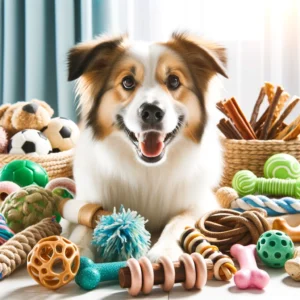Improve Your Dog’s Health: Avoid Plastic Chew Toys
Recent research has highlighted another reason to reconsider giving your dog plastic chew toys: microplastics. Microplastics, tiny fragments of plastic less than 5 millimeters in size, have been found in dog organs and testes. These microplastics are composed of polymers like polyethylene and polyvinyl chloride (PVC), commonly found in plastic packaging and household items.
Thus, researchers discovered microplastics not only in humans but also in dogs, with a variety of polymers identified. Dogs from both public and private veterinary clinics showed significant levels of microplastics, suggesting widespread exposure.
Why Avoid Plastic Dog Toys?
Microplastic Exposure: Chewing on plastic toys can expose your dog to microplastics, which may enter their system and accumulate in various organs, including the testes.
Health Risks: These microplastics can potentially cause cellular damage, oxidative stress, and disrupt normal bodily functions, leading to long-term health issues. Studies have shown that these tiny particles can infiltrate critical organs, posing serious health risks.
Environmental Impact: Plastic pollution is a global issue, with vast amounts of plastic waste affecting ecosystems. Microplastics have been found in oceans, rivers, and even in the air we breathe. By choosing alternatives to plastic, you can help reduce your dog’s environmental pawprint and contribute to a cleaner planet.
Healthier Alternatives to Plastic Chew Toys
Natural Rubber Toys: Durable and safe, natural rubber toys are free from harmful chemicals. They provide a resilient chew option that is gentle on your dog’s teeth and gums while being eco-friendly.
Rope Toys: Made from cotton or other natural fibers, rope toys are a safe and fun option. They are excellent for interactive play and can help clean your dog’s teeth as they chew and pull.
Edible Chews: Opt for natural, digestible chews like bully sticks or antlers. These chews not only satisfy your dog’s instinct to chew but also provide nutritional benefits.
Fabric Toys: Soft toys made from safe, non-toxic materials can be a good alternative for gentle chewers. They come in various shapes and sizes, making them a versatile option for playtime.
Additional Tips for Choosing Safe Dog Toys
- Check for Certification: Look for toys that are certified free of harmful chemicals. Certifications can provide assurance that the products meet safety standards.
- Regular Inspection: Regularly inspect your dog’s toys for signs of wear and tear. Replace any toys that are breaking apart to prevent ingestion of small pieces.
- DIY Options: Consider making your own dog toys using safe, natural materials. There are many DIY guides available online for creating simple, fun toys from household items.
Conclusion
To enhance your dog’s health, avoid plastic chew toys and opt for safer alternatives. This simple change can help reduce your pet’s exposure to harmful microplastics and contribute to their overall well-being. By choosing natural rubber toys, rope toys, edible chews, and fabric toys, you not only ensure your dog’s safety but also support a healthier environment.
Making informed choices about the products you give your pets can lead to a happier, healthier life for them and a more sustainable world for all of us.
